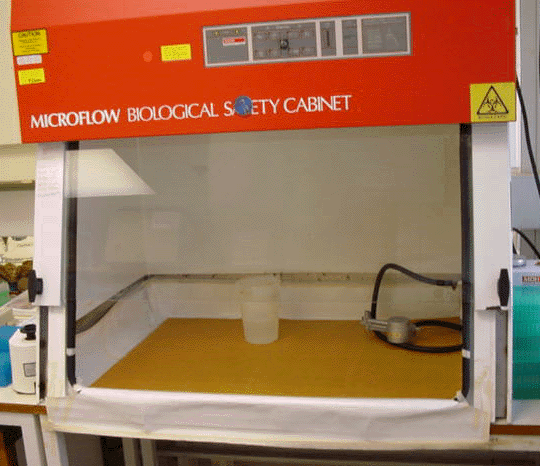
Class I Microbiological Safety Cabinet
Microbiological Safety Cabinets
Microbiological safety cabinets are designed to capture and retain infected airborne particles released in the course of work and to protect the laboratory worker from inhaling them. Until recently, safety cabinets had an unrivaled record of poor installation and misuse. There are three classes of safety cabinets.
Class I - air is drawn from the room through the open front, and over the working area. It is then passed through high efficiency particulate air (HEPA) filters which remove infectious particles, and is ducted to outside air. A minimum airflow of 0.7 m/s must be maintained through the front of the cabinet. Filters must be changed when the airflow falls below this level.
Class II - air is filtered and most of it is recirculated through the cabinet. This cabinet protects the work as well as the worker. About 70% of the air is recirculated through filters so that the working area is bathed in clean (almost sterile) air. The remaining 30% of air is exhausted to the atmosphere and is replaced by a "curtain" of room air which enters at the working face.
Class III - Class III cabinets are totally enclosed and leak-proof. The operator works with gloves which are sealed into the front of the cabinet by removable gaskets.
Laminar flow (clean air) cabinets - these are not microbiological safety cabinets. Air is drawn through HEPA filters and passed onto the working surface and the room. They are widely used in pharmacies and the preparation of tissue culture.
The siting of safety cabinets are important. The main problems are caused b draughts from doors and windows and the movement of people and therefore, safety cabinets should not be sired near doors. HEPA filters are highly efficient in removing viable microorganisms with a quoted efficiency rate is 99.997%. It is important to ensure that ducted effluents are not discharged near to open windows, especially of hospital wards
Class I Microbiological Safety Cabinet
Class II Microbiological Safety Cabinet
Class III Microbiological Safety Cabinet
Decontamination of safety cabinets
The working surfaces and walls of safety cabinets should be decontaminated on a day-to-day basis by swabbing with disinfectant. Glutaraldehyde is probably the best disinfectant for this purpose as phenolics may leave sticky residues and hypochlorites may, in time, corrode the metal. For thorough decontamination e.g. after spillages, before maintenance, filter changing and testing, fumigation is necessary. This may be done by formalin or vaporized glutaraldehyde. Before fumigation, the installation should be checked to ensure that none of the gas can escape to the room or other rooms. Formaldehyde is generated by boiling formalin or by heating paraformaldehyde.